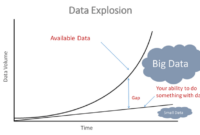Real-time analytics revolutionizes data processing, offering immediate insights and transforming business strategies. Dive into the world of real-time analytics and discover its impact in this captivating exploration.
From defining real-time analytics to exploring its benefits and challenges, this topic delves deep into the realm of instantaneous data analysis, shedding light on its significance in today’s fast-paced digital landscape.
Overview of Real-time Analytics

Real-time analytics refers to the process of collecting, processing, and analyzing data in real-time as it is generated. This allows businesses to make immediate decisions based on up-to-the-minute information. The importance of real-time analytics lies in its ability to provide insights quickly, enabling businesses to respond promptly to changing market conditions and customer behaviors.
Differences Between Real-time Analytics and Traditional Analytics
Real-time analytics differs from traditional analytics in the speed and immediacy of data processing. While traditional analytics often involve batch processing and retrospective analysis of historical data, real-time analytics focus on analyzing data as it is generated, providing instant insights and actionable information.
- Real-time analytics offer immediate insights: Unlike traditional analytics, real-time analytics provide up-to-the-minute insights, allowing businesses to make quick decisions based on current data.
- Dynamic data processing: Real-time analytics can handle large volumes of data in motion, processing and analyzing data streams as they are generated.
- Quick response to changes: With real-time analytics, businesses can respond promptly to changing market trends, customer behaviors, and operational issues.
Benefits of Implementing Real-time Analytics for Businesses
Implementing real-time analytics can offer numerous benefits to businesses looking to stay competitive in a fast-paced environment.
- Improved decision-making: Real-time analytics provide timely insights that enable businesses to make informed decisions quickly.
- Enhanced customer experience: By analyzing data in real-time, businesses can personalize customer interactions and deliver relevant offers and services.
- Operational efficiency: Real-time analytics can optimize processes, detect issues in real-time, and improve overall operational efficiency.
- Competitive advantage: By leveraging real-time analytics, businesses can gain a competitive edge by responding faster to market changes and customer needs.
Tools and Technologies for Real-time Analytics
Real-time analytics relies on a variety of tools and technologies to process and analyze data in real-time, enabling businesses to make timely and informed decisions. Let’s explore some popular tools used for real-time analytics and compare different technologies that play a crucial role in this process.
Popular Tools for Real-time Analytics
- Apache Kafka: Apache Kafka is a distributed streaming platform known for its high throughput and low latency. It allows for real-time data processing by enabling the collection, storage, and analysis of data streams.
- Spark Streaming: Spark Streaming is an extension of the Apache Spark platform that enables real-time data processing and analytics. It provides high fault tolerance and scalability, making it ideal for handling large volumes of data in real-time.
- Amazon Kinesis: Amazon Kinesis is a managed service that allows users to collect, process, and analyze real-time streaming data. It offers capabilities for data ingestion, processing, and visualization, making it a popular choice for real-time analytics.
Technologies in Real-time Analytics
- Apache Kafka vs. Spark Streaming: While Apache Kafka focuses on data ingestion and storage, Spark Streaming is designed for real-time data processing and analytics. Organizations often use both technologies in conjunction to achieve end-to-end real-time analytics capabilities.
- Machine Learning in Real-time Analytics: Machine learning plays a crucial role in enhancing real-time analytics capabilities by enabling predictive analytics, anomaly detection, and personalized recommendations in real-time. Algorithms are used to analyze data streams and provide valuable insights for decision-making.
Challenges in Implementing Real-time Analytics

Implementing real-time analytics can pose several challenges for organizations. From data quality issues to scalability concerns, navigating these obstacles is crucial for maximizing the effectiveness of real-time analytics solutions.
One common challenge faced by organizations is ensuring data quality in real-time analytics systems. Inaccurate or incomplete data can significantly impact the insights derived from real-time analytics, leading to flawed decision-making processes. Maintaining data quality requires robust data governance practices and continuous monitoring to detect and rectify any anomalies promptly.
Another significant challenge is latency issues that can hinder the performance of real-time analytics. Delays in data processing and analysis can diminish the timeliness of insights, reducing the value of real-time analytics solutions. Overcoming latency challenges involves optimizing data pipelines, leveraging high-speed processing technologies, and minimizing network latencies to enable real-time data processing.
Scalability is also a critical challenge in implementing real-time analytics systems. As data volumes grow and processing requirements increase, organizations must ensure that their analytics infrastructure can scale effectively to accommodate the demand for real-time insights. Strategies such as adopting cloud-based solutions, implementing distributed computing frameworks, and optimizing data storage architectures can help overcome scalability challenges and support the expansion of real-time analytics capabilities.
Use Cases of Real-time Analytics

Real-time analytics is being utilized across various industries to gain valuable insights and make data-driven decisions instantaneously. Let’s explore some examples of how different sectors are effectively leveraging real-time analytics for their benefit.
E-commerce
In the e-commerce industry, real-time analytics plays a crucial role in understanding customer behavior, optimizing pricing strategies, and improving inventory management. By analyzing real-time data on website traffic, user interactions, and purchase patterns, e-commerce businesses can personalize the customer experience, recommend products, and enhance overall sales performance.
Finance
Financial institutions rely on real-time analytics to detect fraudulent activities, monitor market trends, and manage risk effectively. Real-time data analysis enables banks and investment firms to identify anomalies in transactions, detect potential fraud, and take immediate action to prevent financial losses. Moreover, real-time analytics helps in predicting market fluctuations, optimizing investment strategies, and ensuring compliance with regulatory requirements.
Healthcare
In the healthcare sector, real-time analytics is instrumental in improving patient care, streamlining operations, and enhancing clinical outcomes. By analyzing real-time data from medical devices, electronic health records, and patient feedback, healthcare providers can make timely and informed decisions, monitor patient health status, and deliver personalized treatment plans. Real-time analytics also facilitates predictive analytics for disease prevention, early intervention, and medical research.
Real-time analytics proves to be invaluable in fraud detection, personalized marketing, and customer retention strategies across industries. By harnessing the power of real-time data insights, organizations can stay competitive, drive innovation, and meet the evolving needs of their stakeholders.
In conclusion, real-time analytics emerges as a game-changer for businesses, providing a competitive edge through swift decision-making and actionable intelligence. Embrace the power of real-time analytics and unlock a world of endless possibilities in data-driven success.
When it comes to scalable data storage , businesses need a solution that can grow with their needs. Cloud storage offers the flexibility to increase storage capacity as required, making it an ideal choice for companies experiencing rapid growth.
Ensuring data security in cloud storage is crucial for protecting sensitive information. With advanced encryption and access controls, cloud storage providers offer a secure environment for storing valuable data, giving businesses peace of mind.
Utilizing MongoDB storage can provide businesses with a powerful and flexible database solution. With its ability to handle large volumes of data and support complex queries, MongoDB is a popular choice for companies looking to scale their data storage capabilities.



